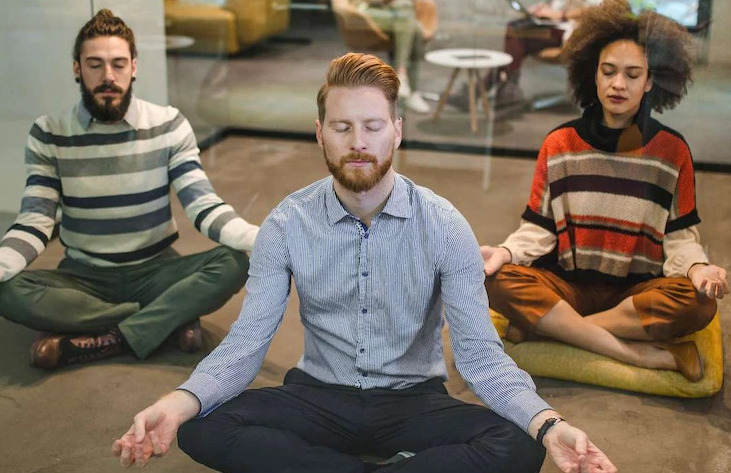Lay Mindfulness Meditation Expands Across Theravada Countries, Including Thailand and Laos, and to the West
Introduction
Burmese independence leader and prime minister U Nu tried every possible course of action to spark an interest of the common Burmese people in insight meditation.
The “New Burmese Method”, which was introduced by U Nārada, an acclaimed Burmese monk, was promoted by his prodigal students such as Mahasi Sayadaw on a global level, beginning with countries such as Thailand, Laos, Sri Lanka, Cambodia and subsequently, other non Theravada countries in Asia and the West.
U Ba Khin, another high-ranking civil servant in independent Burma, played a key role in establishing vipassana meditation world-wide. Some of his famous students include Ruth Denison, Robert Hover, John Coleman and Satya Narayana Goenka (S.N Goenka), who exposed thousands in the West to the techniques of vipassana meditation later on.

How Prime Minister U Nu Made Insight Meditation Accessible to the Burmese People
As Burma freed herself from the shackles of British colonialism, the new Burmese government, under the leadership of its the-then Prime Minister U Nu, tried its best to fuel the interest of the Burmese people in insight meditation. Their strategies were an integral part of a larger political plan that aimed at uniting the common people under the banner of Buddhism.
Insight meditation was more than just attaining salvation or enlightenment or restoring the sasana. It had already become a sentiment, an emblem of patriotism and brotherhood for the independent, young Burma. In fact, in less than eight decades, from 1886 through to the mid- 1950s, meditation became a way of life, the moral responsibility for an ideal citizen of Burma, evolving from a practice that was reserved for a limited few ascetics of the highest order (Braun, 2014).
If you wish to understand how Lay mindfulness (Vipassana) was born in the cauldron of colonial Burma, please visit this page.
The Mahasi Technique of Vipassana Meditation and its Spread to Sri Lanka, Thailand and the West
U Nārada (1868–1955), also popularly known as Mingun Jetawun Sayādaw or Mingun Jetavana Sayādaw, was a Burmese monastic and was considered by many as one of the most influential monks, responsible for promoting vipassana meditation far and wide.
The “New Burmese Method” was predominantly his brain-child, and was introduced by his close disciples such as Mahasi Sayadaw to various parts of the world, including Sri Lanka in 1939. It reached its peak of popularity in the 1950s amongst the lay population with the assistance of a cohort of Burmese monks and meditation teachers. The practice spread widely among the Thai and Sri Lankan populations, starting in 1956 (Sharf, 1995).
Mahasi Sayadaw ventured into other countries in Asia, and even to the West in order to introduce these new mindfulness techniques, which eventually grew into a large-scale, global movement (Braun, 2014).
This technique, which has its origin in the Satipaṭṭhāna Sutta, teaches a meditator how to concentrate on breathing, both inhalation, and exhalation. It is preceded by a preparatory stage, the practice of sila, when one is instructed to renounce one’s materialistic thoughts and desires to free one’s mind (Wilson, 2014; Sayadaw, 2016).
Mahasi Sayadaw‘s Meditation Movement Spreads Beyond the Burmese Borders
While working tirelessly for the promotion of mindfulness meditation amongst the common people in Burma, the Burmese Prime Minister U Nu appointed Mahasi Sayadaw as the resident teacher and head of a newly established meditation center-Thathana Yeiktha Meditation Center in Rangoon (now Yangon). U Nu was in awe of Mahasi Sayadaw and the way he revolutionised vipassana meditation so that it became easily comprehensible and available to the common people (Braun, 2014).
In fact, the meditation movement initiated by Mahasi Sayadaw was so well accepted in Burma that it spread like wildfire to countries such as Thailand, Laos, Sri Lanka and Cambodia, which also followed the Theravada school of Buddhism. Drawing inspiration from the teachings of Mahasi Sayadaw and the seasoned practitioners trained by him, these countries, in turn, set up their own meditation centers. A record number of 700,000 people were believed to receive lessons on insight meditation from Mahasi Sayadaw and his disciples in Burma and beyond (Mahattanadull & Nimanong, 2018).
His techniques became so famous that the Thai Minister for Sangha Affairs persuaded him to travel to Thailand and educate the general Thai population about the techniques and what he considered to be the life-alternating benefits of vipassana practices in 1952. Mahasi Sayadaw was accompanied by two of his most distinguished disciples U Asabha and U Indavamsa on this mission, which became a phenomenal success in just a few days. Innumerable vipassana meditation centers came into existence in Thailand, and more than 100,000 Thai people came into contact with insight meditation (Mahattanadull & Nimanong, 2018).
Even devotees from abroad traveled to Rangoon (now Yangon) to study under Mahasi Sayadaw to understand in-depth his vipassana meditation technique. His first batch of eminent international students included British Rear-Admiral Ernest Henry Shattock, who eventually authored a book called “An Experiment in Mindfulness,” inspiring thousands of Westerners to embrace insight meditation. Amongst other students, the notable ones included Mr. Robert Duva, an American of French descent, who renounced all materialistic pursuits and devoted himself to Buddhism (Mahattanadull & Nimanong, 2018).
Anagarika Shri Munindra, another disciple of Mahasi Sayadaw, came all the way from Bodh Gaya, India to learn about meditation from Mahasi Sayadaw. Joseph Goldstein, an American, who was one of the pioneers of vipassana movement in the West, also received training from Mahasi Sayadaw and later on, wrote numerous books on vipassana meditation (Mahattanadull & Nimanong, 2018).
U Ba Khin’s Initiatives to Promote Vipassana in the West, Thailand, Laos and Other Southeast Asian Countries
U Ba Khin became the Accountant General in the newly independent Burma, and he continued to serve the Burmese Government for the next 20 years, as a high-ranking civil servant. In 1950, he laid the foundation stone of the Vipassana Association of the Accountant General’s Office, which only catered to the lay employees (Wikipedia Contributors, Sayagyi U Ba Khin,” n.d.).
Later, in 1952, he founded another meditation school, the International Meditation Center, in the capital city of Rangoon (now Yangon) in order to reach out to the masses and build their awareness around insight meditation. International students from diverse backgrounds had the privilege to familiarize themselves with the basic tenets of vipassana meditation under his guidance, and some of them, later on, became experts in the field in their own right. His students included eminent scholars, Western Buddhists, and even diplomats from Rangoon (now Yangon)(Wikipedia Contributors, “Sayagyi U Ba Khin,” n.d.).
With the guidance of these two wise mentors, U Ba Khin and Mahasi Sayadaw, the expansion of insight meditative practices did not remain confined only to the Burmese territory but spread exponentially across the world.
U Ba Khin’s Students Promoted Vipassana in the West and the Rest of the World
U Ba Khin delivered lessons on mindfulness to students from all over the world who came to study in his school. Some of the renowned graduates of his school- Ruth Denison, Robert Hover, and John Coleman played a central role in popularizing his techniques in the West. In 1956, U Ba Khin also trained one of the most distinguished teachers of vipassana meditation, Satya Narayana Goenka (S.N Goenka). He was of Indian origin, born to a business family in Burma, and he initially approached U Ba Khin to find a cure for his crippling headache, but fate had other plans (Braun, 2014).
In spite of the initial hiccups that he faced, S.N Goenka, through his unfaltering dedication, mastered the techniques of insight meditation. He eventually worked his way up to become a principal teacher of vipassana meditation (Ba Khin, n.d.).
U Ba Khin always encouraged him to return to India to introduce the techniques of vipassana in its quintessentially purest form to the Indians. He firmly believed that Burma was indebted to India in many ways, which could only be paid off through the “jewel of the Dhamma.” In the words of U Ba Khin, it was the moral responsibility of S.N. Goenka, as an Indian, to offer this jewel to those deserving Indians with good parami (virtues). Later on, as he returned to India in 1969, S.N. Goenka established a chain of over 120 non-commercial Vipassana meditation centers on a global level (Braun, 2014).
By 1988, S.N. Goenka offered a thorough and guided introduction to the practice of vipassana meditation, following the style of his mentor U Ba Khin, to thousands of vipassana enthusiasts, including Westerners, in almost 341 locations and 94 countries in the world. Today dozens of countries are dotted with innumerable vipassana retreats and training centers bearing his name. India alone boasts 78 centers, thanks to the indefatigable spirit of S.N. Goenka (“Vipassana pioneer SN Goenka is dead,” 2013; “Vipassana guru SN Goenka no more,” 2013; “Vipassana Meditation,” n.d.).
Evolution of Vipassana Meditation According to the Needs and Cultural Contexts of the Meditators
The practice of vipassana meditation has evolved enormously over the years and changed in the context of the new countries and cultures it is practiced in. The mindfulness movement in the West is very different from its original Burmese version that came into existence about a century ago. For instance, American and European practitioners of insight meditation primarily lay emphasis on sati or bare attention, inspired by the teachings of Mingun Sayadaw. At the same time, they reconceptualized insight meditation as the means to therapeutic and transformational life experiences, where meditation met psychology. Many Western practitioners sought to transform insight meditation into a secular practice (Braun, 2014).
The ongoing developments of insight meditation practices have unraveled one of the most fascinating and eye-opening discoveries. Meditation, in its quintessentially purest form, as a single, constant entity, is possibly a myth. The modern techniques of insight meditation have been adaptations of earlier techniques of practice that have sprung into existence in various contexts over the years (Braun, 2014).
If you wish to know about how the Westerns discovered the lay vipassana movement, not necessarily realizing its colonial origins, please click on this link.
Sources
Braun, E. (2014). How colonialism sparked the global Vipassana movement. https://tricycle.org/magazine/meditation-en-masse
Mahattanadull, S., & Nimanong, V. (2018). Insight Meditation in Myanmar and Thailand Based on Venerable Mahāsi Sayadaw’s Teaching.(17th ed.).
Sayadaw, M. (2016). Manual of Insight. Wisdom Publications.
Sharf, R. H. (1995). Buddhist Modernism and the Rhetoric of Meditative Experience. http://www.jstor.org/stable/3270219
Vipassana guru SN Goenka no more. (2013, September 30).DNA India. https://www.dnaindia.com/india/report-vipassana-guru-sn-goenka-no-more-1896310
Vipassana Meditation. (n.d.). www.dhamma.org
Vipassana pioneer SN Goenka is dead. (2013, September 30). Zee News. https://zeenews.india.com/news/nation/vipassana-pioneer-sn-goenka-is-dead_880114.html
Wikipedia contributors. Sayagyi U Ba Khin. In Wikipedia, The Free Encyclopedia. Retrieved 23:13, January 19, 2023, from https://en.wikipedia.org/w/index.php?title=Buddhism_in_Myanmar&oldid=1133741614
Wilson, J. (2014). Mindful America: Meditation and the Mutual Transformation of Buddhism and American Culture. Oxford University Press.
